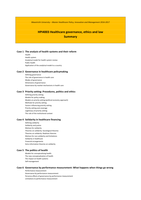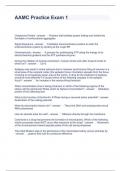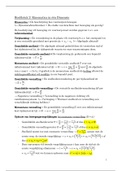HPI4003 Healthcare governance, ethics and law
Summary
Case 1 The analysis of health systems and their reform
Health
Health system
Analytical model for health system review
Public health
Application of the analytical model to a country
Case 2 Governance in healthcare policymaking
Defining governance
The role of governance in health care
Modes of governance
Dimensions of governance
Governance by market mechanisms in health care
Case 3 Priority setting: Procedures, politics and ethics
Defining priority setting
Models for policy making
Models on priority setting (political economy approach)
Methods for priority setting
Factors influencing priority setting
Priority setting and coverage
Legitimacy of priority setting
The role of the institutional context
Case 4 Solidarity in healthcare financing
Defining solidarity
Solidarity and justice
Motives for solidarity
Theories on solidarity: Sociological theories
Theories on solidarity: Rawlsian theories
Motives for non-solidarity and limitations
Solidarity in healthcare
Financial arrangements
Extra information theories on solidarity
Case 5 The politics of health
Models for conceptualizing health
The new conceptualization of health
The impact on health systems
Self-management
Case 6 Governance by performance measurement: What happens when things go wrong
Performance measurement
Governance by performance measurement
Perverse effects of governance by performance measurement
Limitations to performance measurement
, Case 1 The analysis of health systems and their reform
1. What is health?
2. What is public health and what are the aspects of public health model?
3. What is a health system?
4. Explain the analytical model for health system reviews.
5. Apply the analytical model for health system reviews on Germany/UK/Netherlands/US.
Health
Defining ‘health’:
- Health was first defined by the WHO (1984): Health is a state of complete physical, mental
and social well-being and not merely the absence of disease or infirmity. This definition is
doubtful, because according to this, today you can be healthy and tomorrow maybe not.
- Therefore, the Dutch Health Council and ZonMw came up with a new definition (2010), in
which they concluded the following:
o Be aware of the subjectivity of health.
o Health being dynamic instead of ‘a state of’.
o Health being an ability to adapt (resilience).
o Health is strongly context dependent: E.g. including the perspective of children or
elderly.
- The new definition of health is called positive health: Health as the ability to adapt and to
self-manage, in the face of social, physical and emotional challenges.
- 6 dimensions of health:
o Functioning of the body.
o Mental functioning and well-being.
o Spiritual dimension.
o Quality of life.
o Social participation.
o Daily functioning.
Health system
Defining ‘health system’ (Duran):
- Definition WHO: A health system consists of all organizations, people and institutions
producing actions whose primary intent is to promote, restore or maintain health.
- About the definition:
o This definition includes:
§ Health services (personal and population based) and the activities to enable
their delivery provided by finance, resource generation and stewardship
functions.
, § Stewardship, which includes activities seeking to influence positive health
impact of other sectors, even though improving health is not the primary
purpose of these sectors.
The definition can be narrow (talking about the absence of disease as health) or
broad (a holistic view on health).
o Primary intent criterion (WHO): The term ‘primary intent’ is included to enable a
comparison/ranking of all national health systems worldwide. When defining what a
health system is, is can be questioned what the boundaries are. A broad definition of
health systems includes everything that has effect, but this makes it too difficult to
manage. A narrower definition lead to the making of the primary intent criterion.
o Warning notice about the definition: It does not imply any particular degree of
integration, nor that anyone is in overall charge of the activities that compose it.
- Categorization of services by the WHO (which is both generic (applicable across a wide
variety of contexts) and managerially relevant):
o Personal services: Delivered on a one-to-one basis.
o Population-based services: Delivered to a group or entire population.
Goals and functions of health systems:
- 2 dimensions:
o Normative: What health systems should try to achieve, i.e. their goals.
o Rationale: About a social welfare function in which health is an intrinsic component
of welfare, most notably through the impact of good or bad health on incomes.
- Health is one of several social systems (e.g. education, economic, political), each with a
defining goal (i.e. the reason why the system exists).
o Defining goal of a health system: To improve health, although this may affect the
defining goals of other systems.
o The health system also has other goals contributing to social welfare:
§ Improving the health status of the population: The average level of health
and equity in the distribution of health.
§ Improving both the average level and distribution of system responsiveness
when individuals come into contact with the health system: Respect for
persons (ensuring patient dignity, confidentiality and autonomy) and client
(service-user) orientation (prompt attention, basic amenities, choice).
§ Improving fairness in financial contributions, incorporating both avoidance of
impoverishment as a consequence of ‘catastrophic’ health payments and
equitable distribution of the burden of funding the system.
- Function: A group of interdependent activities that every health system undertakes in order
to achieve its goals. Functions are interconnected: Each function is linked with all the others.
o The production of health services: The purpose production of services is at the core
of all health systems. Poor coordination between institutions, people and resources
(which are intended to improve health) could lead to waste and inefficiency.
o Financing: Dealing with the sources, accumulation and allocation of funds used for
the health system (revenue collection), pooling and purchasing (allocation of
resources from the pool to providers).
, o Identification, creation and development of the resources required to produce
health services and to build a health system: Knowledge, staff, facilities, technology.
o Stewardship (rentmeester, geld- of goedbeheerder): The ensemble of activities aimed
at ensuring that health actions have a clear direction and are carried out in ways that
maximize the likelihood of achieving the systems goals.
- Difference between goals and functions:
o Goals: Normative and value-driven, i.e. what health systems should try to achieve.
o Functions: Positive, i.e. a value-free descriptive tool, and generic (applicable to all).
§ Example of the interconnectedness of functions: some health promotion
services are personal (e.g. administering vaccine to an infant) and some are
population based (implementing a radio campaign). Both require specific
resources and funds in order for these to become health interventions
delivered to individuals or the community. Decisions on which services to
produce, in what numbers and under which regulatory conditions, are
influenced by the priorities of the health system concerned.
o Example: Every health system performs the functions, whether or not they are
recognized or explicit. But this does not mean that it is not possible to attempt a
more normative approach by describing the ideal. E.g. good health financing
responds to the health priorities of a country while providing the right incentives to
improve the performance of health professionals. Good purchasing should link
resource allocation to information on providers’ performance or the health needs of
the population being served. Similar reasoning could be applied to the characteristics
of the other functions (e.g. good resource generation, good service production).
Challenges to politicians, posed by health systems (Duran):
- Advances in medical technology: They have raised expectations about what health systems
can deliver, causing continuing upward pressure on costs.
- Ideas for reform hold out the promise of cost-containment but rarely manage to deliver.
- Outcomes achievable in theory are not always achieved in practice.
- Health ministers can be disadvantaged by the lack of clarity about the boundaries of the
health system.
- Frustrated managers by the apparent lack of mechanisms at their disposal to bring about
change, while the political dimension of health policies adds to the complexity: They often
assume responsibility for failure, but they may have little control over the necessary actions.
Analytical model for health system review
An analytical model for health system review:
- An analytical model offers a conceptual framework for systematic description to gain clear
insight into the structure of any health system – without drowning in an overwhelming
amount of detail. Such a model must provide attention to the main characteristics of the
structure, functioning and performance of a health system, while abstracting from all kinds
of specifics and exceptional situations.
, - A good analytic model is also indispensable (onmisbaar) when comparing international
health systems and the reforms made to those systems over time: it helps to identify the
distinctive features of health systems and to determine what the most important similarities
and differences are between systems; for the systematic description, analysis, comparison
and evaluation of health systems.
- 2 main applications of the analytical model (!):
o To describe and compare individual health systems: E.g. the health system of the
Netherlands, Germany, the UK or the USA. Each health care system has its own
characteristics: Not one health care system is the same.
o Usage of the framework to support national decision-making (Duran):
§ For development of a coherent, goal-oriented health reform strategy.
§ For performance assessment and monitoring.
The analytical model for health system review, developed by the WHO:
Linkage between the different parts of the framework (Duran):
, The analytical model for health system review, developed by the WHO:
- Structured as an input-output model: The process of turning inputs into outputs is called
conversion. So, the process goes: Input à Conversion à Output à Feedback (!). It includes
a feedback loop to indicate that outputs can flow back into the health system as new input:
- The analytic model constitutes a simplified and abstract representation of the complex
reality of health systems.
- The health systems function in a broader environment consists of several parts, in which the
health system is formed by the functions, intermediate objectives and health system goals.
o The context (the health system): A health system exists within a broader context.
The context are external factors which influence that system (see case 5). The
intermediate or final outputs. E.g. the socio-cultural background, demographics
(many old people, many chronic illnesses in the task environment). The health care
system needs to be designed to take care of many chronic illnesses. The context
(in)directly influences the health system (indirectly through the task environment).
o The task environment: The health problems that should be targeted by a health
system. The existing healthcare demands, which are inputs to the health system.
§ It is the operationalisation of health system goals in tangible things.
§ The task environment is a responsibility, a task of the health care system: A
health care system can solve or treat the task environment.
§ The task environment is defined by the context (e.g. demographic), so it
changes over time.
§ E.g. in a context with a very strong opinion about HIV/Aids, by not helping
people with that disease, then it is no part of the task environment.
o Functions: Everything that makes the health care system happen.
§ Governance (stewardship) (see case 2 and 3): Health system coordination.
Common in definitions is that is describes ‘how things are done’, ‘the rules of
the game’. Oversight. All other functions come together.
• Defining health care governance:
o Systematic, patterned way in which decisions are made and
implemented (Greer).
o The way that policymakers try to manage, coordinate or
control the activities of healthcare actors (Giaimo).
o Specific mode of production norms (decision, rules, politics)
that can be called co-production where co-producers are
different kind of actors (private and public) (Bartolini).
• Relevance for health care governance (!): It shapes its ability to
respond to the various challenges that health systems face today
(Greer). E.g. expensive drugs, global infectious disease outbreaks.
• There are different ways of governing: Hierarchy, market, or a form
in between.
• E.g. Inspectorate is part of governance.
§ Resource generation: E.g. investment and training, the pharmaceutical
company when they do research, as a company. The wealthier a health
system, the more resources that are available. E.g. through taxes, private
and public insurances.











